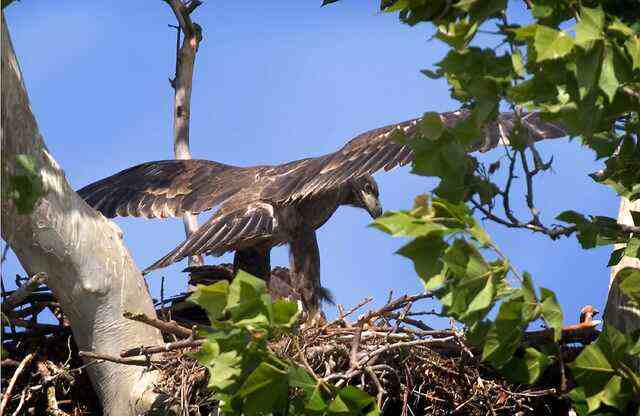Do Eagles Eat Earthworms? Prepare to be amazed as we embark on a whimsical journey into the captivating world of these majestic and powerful birds of prey.
Discover the diverse and adaptable diets of eagles, including their surprising taste for earthworms.
Join us as we delve into the intricacies of their feeding habits, explore the factors influencing their dietary choices, and unravel the challenges they face.
Get ready for a captivating exploration of the remarkable adaptability and conservation needs of these avian predators!
Table of Contents
- 1 Key Takeaways
- 2 Do Eagles Eat Earthworms
- 3 Introduction to Eagle Feeding Habits
- 4 Overview of Eagle Diets
- 5 Exploration of Unusual Prey
- 6 Eagle Feeding Techniques and Adaptations
- 7 Importance of Diet Variation for Eagles
- 8 Potential Benefits of Eating Earthworms
- 9 Case Studies and Observations of Eagles Consuming Earthworms
- 10 Limitations and Challenges of Earthworm Consumption
- 11 Factors Influencing Eagle Feeding Habits
- 12 Further Research and Conservation Efforts
- 13 Conclusion and Summary of Eagle Feeding Habits
- 14 Frequently Asked Questions
- 14.1 Can eagles survive solely on a diet of earthworms?
- 14.2 Are there any negative effects on eagles if they consume too many earthworms?
- 14.3 How do eagles locate and capture earthworms?
- 14.4 Are there any specific seasons or times of the year when eagles prefer to eat earthworms?
- 14.5 Do different species of eagles have different preferences for earthworms as part of their diet?
- 15 Author
Key Takeaways
- Eagles have diverse diets and can consume earthworms when other food sources are scarce.
- Earthworms provide essential nutrients like protein, calcium, phosphorus, and omega-3 fatty acids for eagle health and well-being.
- Earthworms contribute to the natural recycling of organic matter and nutrient cycling within ecosystems.
- Availability of earthworms in certain habitats can be limited for eagles, especially in areas with large bodies of water.
Do Eagles Eat Earthworms
While eagles are primarily known for their diet of fish and small mammals, they are not typically known to eat earthworms. Eagles prefer larger prey that provides more sustenance.
Their hunting techniques and adaptations are better suited for capturing and consuming animals that are more substantial in size.
Introduction to Eagle Feeding Habits
The feeding habits of eagles encompass a diverse range of prey species, including but not limited to earthworms.
Eagle foraging behavior is influenced by various factors, such as habitat type, prey availability, and competition with other predators.
Eagles are opportunistic hunters and have adapted to exploit a wide array of food sources.
However, it is important to note that the dietary preferences of eagles may vary depending on their species and geographical location.
While some eagles primarily feed on fish, others may consume small mammals, birds, reptiles, and even carrion.
Earthworms, although not a main staple in their diet, can be consumed by eagles when other food sources are scarce.
It is worth mentioning that eagles are apex predators and play a crucial role in maintaining the balance of ecosystems.
In the subsequent section, an overview of eagle diets will be provided, further exploring their dietary preferences and adaptations.
Overview of Eagle Diets
Eagle diets encompass a diverse range of prey items, including small mammals, fish, birds, and invertebrates.
These adaptable raptors have evolved to take advantage of various food sources, allowing them to thrive in different habitats and ecosystems.
The nutritional value of earthworms, for instance, contributes to the overall health and survival of eagles. Earthworms are rich in protein, making them an important part of the eagle diet.
In addition, they provide essential vitamins and minerals that aid in the growth and development of these magnificent birds.
Other prey items, such as fish, offer omega-3 fatty acids that promote good heart health and enhance the eagle’s reproductive success.
These diverse dietary adaptations highlight the versatility and resourcefulness of this apex predator.
Moving forward, the exploration of unusual prey will shed light on the fascinating feeding habits of these majestic creatures.
Exploration of Unusual Prey
Expanding the scope of inquiry, the examination of unconventional quarry will illuminate the intriguing dietary proclivities of these majestic avian predators.
Eagles, known for their preference for fish and small mammals, have been observed to consume a wide range of unusual prey.
To explore these unconventional food choices, researchers have employed various exploration methods including direct observation, analysis of regurgitated pellets, and examination of prey remains in nests.
Through these investigations, it has been discovered that eagles occasionally feed on earthworms, reptiles, amphibians, and even carrion.
While these choices may seem surprising, they provide additional nutritional value to the eagles’ diet, contributing essential nutrients such as proteins and minerals.
These discoveries highlight the adaptability and opportunistic nature of eagles as they exploit diverse food sources.
Transitioning into the subsequent section about ‘eagle feeding techniques and adaptations,’ it is intriguing to explore how these birds capture and consume their varied prey.

Eagle Feeding Techniques and Adaptations
This discussion will focus on the hunting techniques employed by eagles when targeting fish and small mammals as their prey.
Eagles have developed specialized adaptations to effectively capture these types of prey, including their powerful talons and strong grip.
Their hunting techniques involve a combination of aerial maneuvers, precise diving, and swift swoops to secure their desired food sources.
Hunting Techniques for Fish and Small Mammals
Hunting techniques employed by eagles for capturing fish and small mammals are a fascinating display of precision and agility.
These majestic birds have evolved a variety of strategies to successfully catch their prey.
When hunting fish, eagles use a technique known as plunge diving, where they soar high above the water and then dive, extending their talons just before reaching the surface.
This allows them to snatch fish right out of the water with their powerful grip.
For small mammals, eagles employ different methods, such as soaring and scanning the ground for movement, or perching on a high vantage point and then swooping down to capture their prey.
Their sharp eyesight and incredible speed make them formidable hunters.
Transitioning into the subsequent section about ‘talon strength and grip for capturing prey’, eagles rely on their powerful talons to secure their catch and maintain a firm grip during flight.
Talon Strength and Grip for Capturing Prey
With their sharp and formidable talons, eagles possess a grip that is as unyielding as the grip of a vice. These talons are specifically adapted for capturing and holding onto prey, allowing eagles to effectively secure their catch.
The talon grip of eagles is an essential component of their prey capture techniques. The talons are curved and razor-sharp, enabling eagles to pierce through the flesh of their prey and firmly grasp it.
Additionally, the talons have strong muscles and tendons that provide eagles with exceptional gripping strength. This allows them to hold onto struggling prey, preventing it from escaping.
The talons are also instrumental in immobilizing the prey, as eagles can squeeze and apply pressure with their grip, further incapacitating their catch.
Understanding the talon grip and its role in prey capture is crucial in comprehending the importance of diet variation for eagles, as it directly influences their ability to secure and consume different types of prey.
Importance of Diet Variation for Eagles
Diversifying their diets is crucial for eagles to maintain optimal health and well-being. By incorporating a variety of prey into their diet, eagles can ensure they receive all the necessary nutrients and minerals.
The importance of dietary diversity cannot be overstated, as it directly impacts the overall health of these majestic birds.
Earthworms, although not commonly associated with eagles, can provide numerous benefits. Firstly, earthworms are an excellent source of protein, which is essential for muscle development and growth.
Additionally, they contain high levels of calcium, phosphorus, and other minerals that support bone strength and density.
Lastly, earthworms are rich in omega-3 fatty acids, which promote heart health and reduce inflammation.
Therefore, including earthworms in their diet can offer eagles a range of potential benefits.

Potential Benefits of Eating Earthworms
Including earthworms in their diet can offer eagles a range of potential benefits, such as increased protein intake for muscle development and growth, enhanced bone strength and density from the high levels of calcium and phosphorus, and improved heart health due to the omega-3 fatty acids they contain.
Earthworms are highly nutritious, providing essential amino acids that eagles require for their metabolic processes.
Additionally, the high moisture content in earthworms can help maintain proper hydration levels in eagles, especially in arid environments.
The potential ecological impact of including earthworms in an eagle’s diet is significant as well.
By consuming earthworms, eagles can contribute to the natural recycling of organic matter and play a role in nutrient cycling within ecosystems.
Understanding the nutritional value and ecological importance of earthworms for eagles can be further explored through case studies and observations of eagles consuming earthworms.
Case Studies and Observations of Eagles Consuming Earthworms
Case studies and observations have revealed the fascinating sight of majestic eagles gracefully devouring earthworms, showcasing the intricate relationship between these powerful birds and the earth’s humble soil-dwellers.
When it comes to eagle foraging behavior, earthworms are an important food source due to their nutrient content.
Eagles are known to consume earthworms as part of their diet, particularly during the breeding season, when they require high energy levels.
The nutrient-rich composition of earthworms, including proteins, fats, vitamins, and minerals, provides essential nourishment for these birds.
Additionally, earthworms are easily accessible for eagles as they can be found in various habitats, including grasslands, wetlands, and agricultural areas.
This adaptability allows eagles to incorporate earthworms into their diet regardless of their location.
However, despite the benefits, there are limitations and challenges associated with earthworm consumption that will be discussed in the subsequent section.
Limitations and Challenges of Earthworm Consumption
Despite the advantages of incorporating earthworms into their diet, there are certain limitations and challenges associated with the consumption of these soil-dwellers.
One limitation is the availability of earthworms in certain habitats. Eagles predominantly inhabit areas with large bodies of water, such as lakes and rivers, where their primary prey consists of fish.
Therefore, earthworms may not be readily accessible in these environments, making it difficult for eagles to include them in their diet.
Additionally, eagles have specific dietary requirements that may not be fully met by earthworms alone.
Earthworms are high in protein, but they lack essential nutrients such as vitamins and minerals that are crucial for an eagle’s overall health and survival.
This poses a challenge for eagles relying solely on earthworms as their main food source.
Transitioning to the subsequent section about factors influencing eagle feeding habits, various factors such as habitat and prey availability play a significant role in determining the dietary preferences of eagles.

Factors Influencing Eagle Feeding Habits
Eagle feeding habits are influenced by several factors, including geographic location and habitat, seasonal changes, and prey availability.
Geographic location and habitat play a crucial role in determining the types of prey available to eagles.
For example, eagles living near bodies of water may primarily feed on fish, while those in forested areas may rely more on small mammals.
Seasonal changes also impact eagle feeding habits, as certain prey species may become more abundant or scarce during different times of the year.
Finally, prey availability directly affects eagle feeding habits, with eagles adapting their diet based on the availability of prey in their surroundings.
Geographic Location and Habitat
Geographic location and habitat greatly influence the dietary preferences of eagles, as they adapt to the availability of prey species in their surroundings.
Eagles have a wide geographic distribution, ranging from North America, Europe, Africa, and Asia. Within these regions, they occupy diverse habitats such as forests, grasslands, and coastal areas.
These different habitats offer varying prey options for eagles. For example, eagles nesting near bodies of water, such as rivers or lakes, may have a diet primarily composed of fish.
On the other hand, eagles residing in forested areas may rely more on small mammals and birds as their main food sources.
Thus, the geographic location and habitat of eagles play a crucial role in determining their diet. This will be further explored in the subsequent section on seasonal changes and prey availability.
Seasonal Changes and Prey Availability
Seasonal changes and prey availability have been found to significantly impact the dietary composition of eagles, as they adapt to the fluctuating abundance and accessibility of different prey species in their environment.
- Prey migration: Eagles rely on the seasonal movements of their prey for sustenance. They may follow the migration patterns of certain prey species, such as fish or waterfowl, to ensure a consistent food source throughout the year.
- Environmental impact: Changes in the environment, such as temperature, precipitation, and vegetation, can affect the availability of prey. For example, a decrease in rainfall may lead to a decline in the population of earthworms, which in turn affects the eagles’ ability to feed on them.
- Adaptability: Eagles have demonstrated remarkable adaptability in their feeding habits. They are able to switch their diet based on the availability of prey, ensuring their survival even in challenging environments.
In conclusion and summary of eagle feeding habits, their diet is influenced by seasonal changes and prey availability, and they exhibit adaptability to ensure their sustenance.
Further Research and Conservation Efforts
Further investigation and conservation initiatives are necessary to gain a comprehensive understanding of the role and significance of earthworms in the dietary patterns of eagles, as well as to ensure the long-term preservation of their habitats and the availability of suitable prey.
To achieve these goals, funding opportunities should be explored to support research projects focused on the feeding habits of eagles and their reliance on earthworms.
This would involve studying the nutritional value of earthworms, as well as the factors that influence their abundance and distribution in eagle habitats.
Additionally, public awareness campaigns should be implemented to promote the importance of preserving eagle habitats and the need to protect earthworm populations.
By engaging the public in conservation efforts, we can encourage a greater appreciation for eagles and their ecological role, fostering a sense of responsibility towards their conservation.

Conclusion and Summary of Eagle Feeding Habits
In examining the diet of eagles, it becomes evident that their feeding habits encompass a range of prey items, including small mammals, birds, fish, and invertebrates such as earthworms.
Earthworms are an important food source for eagles, especially during certain seasons when other prey may be less available.
While these invertebrates may not provide the same level of nutrition as larger prey items, they offer potential benefits, such as being abundant and easily accessible.
However, there are also limitations and challenges associated with earthworm consumption.
For example, they may not provide the necessary energy requirements for eagles, and their availability may vary depending on factors such as weather conditions and habitat.
Further research and conservation efforts are needed to better understand the significance of earthworms in the diet of eagles and to ensure the preservation of their habitats and prey availability.
Frequently Asked Questions
Can eagles survive solely on a diet of earthworms?
Eagles cannot survive solely on a diet of earthworms due to their low nutritional value. Earthworms lack essential nutrients and are not comparable to other prey items in an eagle’s diet.
Are there any negative effects on eagles if they consume too many earthworms?
Overconsumption of earthworms can have negative effects on eagles. It may lead to nutrient imbalances, digestive issues, reduced diversity in their diet, and potential exposure to harmful substances from contaminated soil.
How do eagles locate and capture earthworms?
Eagles employ various hunting techniques to locate and capture earthworms, which serve as their primary food source. These techniques include visual scanning, aerial stalking, and swooping down with precision and speed, ensuring a successful capture.
Are there any specific seasons or times of the year when eagles prefer to eat earthworms?
Eagles have seasonal preferences for earthworms due to their nutritional value. They may consume more earthworms during seasons when these creatures are abundant and provide essential nutrients.
Do different species of eagles have different preferences for earthworms as part of their diet?
Different species of eagles exhibit variations in their earthworm preferences as part of their diet. These variations highlight the diverse dietary habits among eagle species, emphasizing the need for species-specific studies in understanding their feeding ecology.




